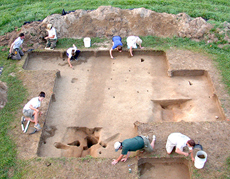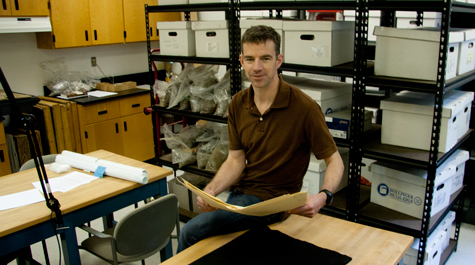Ceremony will mark Werowocomoco preservation agreement
The site of Werowocomoco, Powhatan’s capital city during the early years of the Jamestown Colony, will be preserved from development or disturbance.
Robert and Lynn Ripley, owners of the property near Gloucester, have entered into an agreement with the Virginia Department of Historic Resources to preserve the 57 acres of the Werowocomoco site.
The agreement will be announced at a June 21 ceremony at the site. Speakers scheduled for “Coming Home to Werowocomoco” include Virginia Gov. Bob McDonnell and Kathleen Kilpatrick, director of the Department of Historic Resources.
 Martin Gallivan, professor of anthropology at William &
Mary, will also speak, as will Ashley Atkins and Jeff Brown, both members of
the Pamunkey tribe. All three participated in the archaeology that confirmed
the discovery of Werowocomoco. Both Atkins, an anthropology Ph.D. candidate at
William & Mary, and Brown also participated in the 2011 archaeological
examination of the Brafferton, site of William & Mary’s Indian School.
Martin Gallivan, professor of anthropology at William &
Mary, will also speak, as will Ashley Atkins and Jeff Brown, both members of
the Pamunkey tribe. All three participated in the archaeology that confirmed
the discovery of Werowocomoco. Both Atkins, an anthropology Ph.D. candidate at
William & Mary, and Brown also participated in the 2011 archaeological
examination of the Brafferton, site of William & Mary’s Indian School.
The conservation easement is the latest preservation development for the site. Werowocomoco earned a spot on the National Register of Historic Places in 2006. The easement has renewed public interest in Werowocomoco, as well, with advance media coverage in USA Today as well as an Associated Press story that focused national and international attention on the site.
The site, on the York River in Gloucester County, was identified in 2003 as the political center of Powhatan’s extensive Tidewater chiefdom, which stretched from the Potomac to south of the James and from the Eastern Shore to the fall line near today’s I-95. Since 2003, archaeological work by Gallivan and others has confirmed the site’s identity as Werowocomoco.
Gallivan, who is finishing a book on Werowocomoco and other native chiefdoms of the region, points out that “Powhatan” is the name commonly used for the individual whose name was Wahunsenacawh. Gallivan describes Werowocomoco as “a place of power,” the seat of religious and secular authority in an area known as Tsenacommacah, which extended from Virginia’s Eastern Shore westward to where I-95 runs today.
He noted that Werowocomoco had been a place of power for centuries before the 1607 founding of Jamestown. It’s known for being the site of the legendary intervention of Pocahontas in the pending execution of John Smith.
“The story of Pocahontas saving the life of John Smith is part of our national myth,” Gallivan said. “It may never have happened. It probably didn’t happen as the story is commonly understood. But if it did happen, it happened right here at Werowocomoco.”
Gallivan is a member of the Werowocomoco Research Group, a William & Mary-based collection of stakeholders in the site that has, from the beginning, included members of the Pamunkey and other Virginia tribes with connection to the Powhatan people, through its Virginia Indian Advisory Board.
 Skip to main content
Skip to main content

